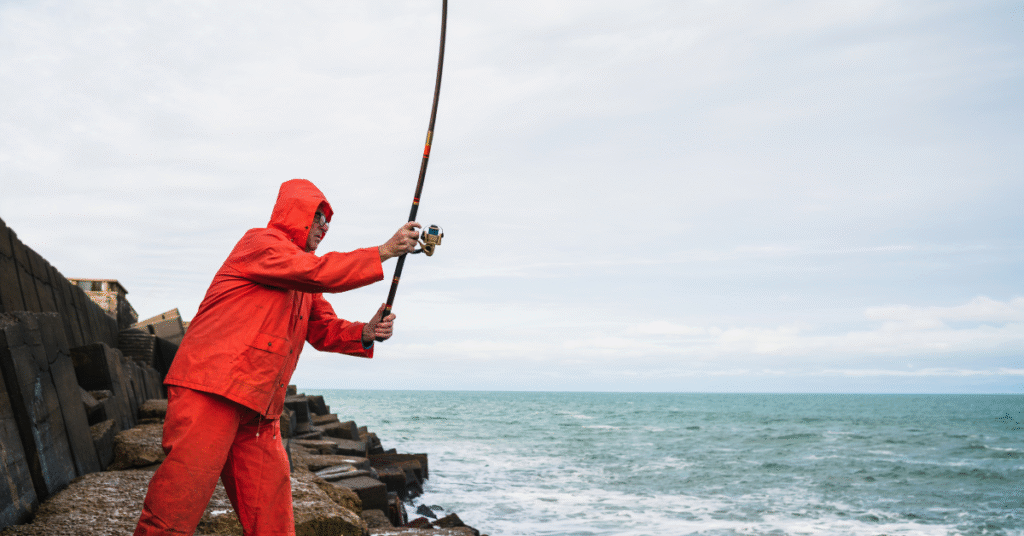Introduction
Swordfishing is a pastime that blends talent, patience, and a thorough study of marine ecosystems. It is well-known for its difficulty and the pure thrill of capturing one of the ocean’s largest predators. It entails pursuing the magnificent and elusive swordfish, a species distinguished by its extraordinary power and speed as well as its long, flat bill, or “sword”. Both daytime and nighttime swordfishing are possible, each with its own special difficulties and methods.
The Swordfishing Story
Swordfishing has existed for thousands of years, but people didn’t always view it as a sport. Ancient societies, including the Greeks and Romans, recorded encounters with swordfish. These large, predatory fish were difficult to capture due to their size and strength, but people also recognized them as a significant source of meat. But swordfishing didn’t develop into the contemporary sport we know today until the late 19th and early 20th centuries.
The main reason fishermen targeted swordfish in the early days of commercial fishing was their meat, which people highly valued for its flavor and quality. Harpooning and spearing the fish were two extremely risky but successful techniques employed during this time. Swordfishing didn’t become popular until fishermen developed better fishing boats, tackle, and more advanced methods. The main reason they targeted swordfish in the early days of commercial fishing was their meat, which people highly valued for its flavor and quality.
Swordfishing: What is it?
The swordfish (Xiphias gladius), a giant predatory fish distinguished by its distinctive long, flattened bill that it employs to slash at food, is the target of swordfishing, a type of big-game fishing. Both the Atlantic and Pacific oceans are home to swordfish, although they are more prevalent in warmer regions. Swordfishing aims to hook and reel in a swordfish, which can weigh several hundred pounds, and people can do it from both commercial and leisure vessels.
Despite being nocturnal predators that mostly feed at night, swordfish sometimes foray into deeper seas during the day. The difficulty of swordfishing stems from the fish’s elusiveness as much as its size and strength. Because of their high intelligence and unpredictable behaviour, swordfish are a popular target for fishermen who enjoy the rush of a good chase.
Strategies for Swordfishing
Depending on the time of day, the area, and the kind of vessel used, swordfishers can choose from various methods. Daytime swordfishing and midnight swordfishing are the two main approaches, and each calls for a unique set of skills.
1. Swordfishing at night:
Experienced fishermen widely prefer swordfishing at night and often regard it as the more conventional approach. This technique capitalises on the swordfish’s innate tendency to feed close to the water’s surface at night. Lights are usually used by anglers to draw swordfish to the surface. Anchoring the boat in a known swordfish habitat, usually over deep waters, is the first step in the operation.
Fishermen tie a bait, like a fish or squid, to the fishing line and lower it into the water to act as the lure. They typically suspend the bait at a depth where swordfish are known to feed. Patience is essential because swordfish are notoriously elusive. When the swordfish strikes, anglers must stay vigilant and prepare to set the hook.
2. Swordfishing during the day:
Thanks to developments in sonar technology, which enable fishermen to find swordfish even in the deepest oceans, swordfishing has become more popular during the day in recent years. Daytime swordfishing, as opposed to nocturnal fishing, involves cruising over a certain area and using sonar to find swordfish underneath. After locating a swordfish, fishermen wait for the fish to bite before dropping their baited lines to the appropriate depth.
Because swordfish are usually found at a deeper depth during the day, swordfishing during the day is often seen as more difficult than fishing at night. Strong reels and heavy tackle are necessary since swordfish frequently dive 1,000 feet or more. Because the fish might not strike right away, anglers need to be ready to wait for extended periods of time. But perseverance will pay off in the form of the chance to catch a genuinely enormous fish.
The Tools Required for Swordfishing
Since swordfish are big and strong, special gear is needed for swordfishing. Having the appropriate equipment can mean the difference between catching and losing a fish. The following is a list of the necessary tools for swordfishing:
1. Rods for fishing:
Swordfish rods must withstand the weight and force of swordfish, typically measuring 6 to 8 feet long. Manufacturers construct these rods from fiberglass or composite materials to ensure they remain strong and flexible enough to endure a swordfish’s powerful strikes.
2. Reels
Swordfishing reels must handle heavy loads and endure grueling, long-distance runs, built specifically for deep-sea battles. Many anglers favor electric reels for their powerful motors that quickly retrieve line after a strike. Yet dedicated traditionalists still opt for manual reels, valuing their precise control and greater challenge.
3. Line of Fishing:
Usually composed of high-strength materials like monofilament or braided line, swordfishing fishing line has a breaking strength of several hundred pounds. Reeling in a swordfish that could weigh hundreds of pounds requires a line that is strong enough to withstand the strain.
4. Hooks
Swordfishing hooks are big and made to pierce the swordfish’s hard mouth. Because they tend to hook the fish in the corner of the mouth, circle hooks are frequently employed because they lessen the possibility that the hook would pull out during a fight.
5. Bait
Swordfish, as carnivores, naturally pursue bait that imitates their prey – typically small fish like squid or mackerel. Many fishermen use live bait, though artificial lures often prove equally effective. They secure the bait to the fishing line and lower it to the depth where swordfish likely hunt.
6. Lighting:
Swordfishers frequently use strong lights to lure swordfish to the surface during nighttime expeditions. They typically position these powerful lights along the boat’s sides, creating an illuminated zone in the water below that attracts the predatory fish.
Top Swordfishing Locations
Where swordfish gather, which is usually in deeper waters, is usually the ideal place to go swordfishing.
1. The Mexican Gulf:
One of the most well-liked locations for swordfishing, particularly in the warmer months, is the Gulf of Mexico. Due to the abundance of swordfish prey in the deep waters, the region is a popular spot for both commercial and recreational swordfishing.
2. Off Florida’s Coast:
One of the best places to go swordfishing is Florida, especially the region surrounding the Florida Keys. It is a popular spot for fisherman looking for swordfish because of the warm seas and large number of baitfish. Additionally, the region enjoys year-round fishing, with the winter months usually seeing the most activity.
3. Off California’s Coast:
Although swordfish in the Pacific Ocean are typically more migratory, the correct circumstances can make this region a popular fishing destination.
4. Off the Mediterranean Coast:
The Mediterranean Sea is another excellent location for swordfishing for anglers in Europe. The area is a great place for both commercial and recreational fishers because of its deep seas and swordfish feeding areas.
Swordfishing Safety Considerations
Swordfishing may be a strenuous and hazardous sport, particularly when interacting with big, strong fish. Safety should always come first, and fisherman should take the following important precautions:
1. Put on a Life Jacket: When swordfishing, especially in open waters, always wear a life jacket that fits properly. Life jackets are a vital piece of safety equipment because of rough waves, erratic weather, and the potential for overboard falls.
2. Recognise Your Limits: The physical effort of hauling in a big fish may be exhausting, and swordfishing might require extended periods of time on the sea. To prevent fatigue and lower the chance of damage, make sure you take breaks and know when to end the day.
3. Have Appropriate Communication: Make sure your yacht has dependable communication tools, including a satellite phone or marine radio. Being able to get in touch with assistance fast is essential in case of an emergency.
4. Employ the Right procedures: To prevent harm, it’s critical to employ the right procedures when working with swordfish. Due to their sharp bills, swordfish can inflict serious damage with their strikes. To keep safe, always utilise the right equipment and handling methods.
Conclusion
Swordfishing is a fascinating sport that provides a special fusion of adventure, challenge, and excitement. Catching a swordfish is a major accomplishment for any angler because they are fierce predators. With the correct planning, preparation, and environmental awareness, swordfishing can be a fulfilling activity that allows fishermen to interact with one of the most magnificent marine life.
FAQs
1. When is the ideal season to go swordfishing?
Although the ideal season for swordfishin varies by region, winter is typically regarded as the finest time of year in many regions, particularly for nighttime swordfishin in the Gulf of Mexico and Florida.
2. Does swordfishing pose a threat?
Because of the fish’s size and strength, as well as the potentially dangerous water conditions, swordfishing can be risky.
3. What is the depth of swordfish swimming?
Particularly during the day, swordfish, which are deep-water predators, can go to depths of 1,000 feet or more. When feeding at night, they typically swim closer to the surface.
4. Is it possible to catch swordfish off the coast?
In certain places, swordfish can be caught from shore, but most swordfishing is done from boats. This is far less common, though, and usually calls for specialised tools and methods.
5. For swordfishing, what kind of bait is used?
As carnivores, swordfish are typically captured using baitfish such as squid or mackerel. In order to improve their chances of success, some fishermen also employ live bait.
6. What is the biggest swordfish that has ever been captured?
The largest swordfish ever recorded was caught off the coast of the Dominican Republic in 1953 and weighed approximately 1,182 pounds (536 kg). On the other hand, the majority of swordfish harvested for recreational purposes weigh between 200 and 400 pounds.






